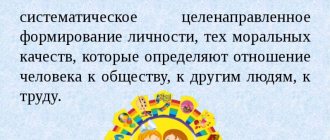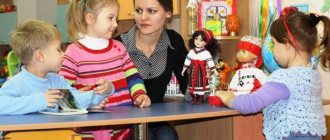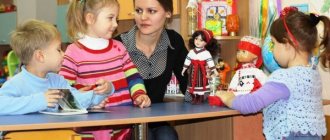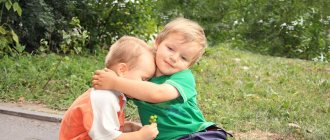Presentation on the topic: “Spiritual and moral education of junior schoolchildren in the field of implementation of the Federal State Educational Standard.”
SPIRITUAL AND MORAL EDUCATION OF JUNIOR SCHOOLCHILDREN WITHIN THE FRAMEWORK OF THE IMPLEMENTATION OF THE FSES
Prepared by Olga Vyacheslavovna Goloborodko,
primary school teacher at MKOU Gubarevskaya Secondary School
“Our children are our old age. Proper upbringing is our happy old age, bad upbringing is our future grief, our tears, our guilt before other people, before the whole country.”
A. S. Makarenko
“The most important goal of modern domestic education and one of the priority tasks of society and the state is education, social and pedagogical support for the formation and development of a highly moral, responsible, creative, proactive, competent citizen of Russia.”
Spiritual and moral education
- one of the aspects of education aimed at assimilation by younger generations and translation into practical action and behavior of the highest spiritual values.
In the education system, spiritual and moral education
is a purposeful process of interaction between teachers and students, aimed at the formation of a harmonious personality, at the development of its value-semantic sphere, by imparting to it spiritual, moral and basic national values. “Spiritual and moral values” are understood as fundamental principles and norms in people’s relationships with each other, with family and society, based on the criteria of good and evil, lies and truth.
4.
The concept of
“spirituality ”
does not have a single interpretation.
Different thinkers have defined it in different ways. In relation to spiritual and moral education, the following highest spiritual values are distinguished:
1. individual and personal (human life, child’s rights,
honor
, dignity); 2. family (father's house, parents, family harmony, family pedigree, its traditions); 3. national (way of life, behavior, communication; Motherland, shrines of the country, national heraldry, native language, native land, folk culture, unity of the nation); 4. universal (biosphere as a human habitat, ecological culture, world science and culture, peace on Earth, and so on).
- In all centuries, people highly valued spiritual and moral education. The profound economic transformations taking place in modern society force us to think about the future of our Motherland and its youth.
- The lack of spiritual development, as is now obvious, has led to moral devastation and impoverishment of human souls. The words are rarely spoken: goodness is a source of joy, peace and harmony in the soul, repentance is renunciation of evil.
- “ But only...A good man brings forth good from the good treasure of his heart, and an evil man brings out evil from the evil treasure of his heart, for out of the abundance of his heart his mouth speaks
”...
Gospel of Luke
.
The relevance of the problem of
spiritual and moral education
- Society needs to prepare well-educated, highly moral people who have not only knowledge, but also excellent personality traits.
- In the modern world, a child develops surrounded by many different sources of strong influence on him, both positive and negative, on the still emerging sphere of morality.
- Moral knowledge informs the child about the norms of behavior in modern society, gives ideas about the consequences of violating these norms or the consequences of this act for the people around him.
Target:
Education, social and pedagogical support for the formation and development of a highly moral, responsible, creative, proactive, competent citizen.
Tasks:
- Fostering spirituality and a sense of belonging to the history of one’s homeland;
- Fostering the need for a healthy lifestyle;
- Formation of a culture of family relationships;
- Formation of universal humanistic norms of humanistic morality;
- Fostering respect for the rights of every individual;
- Fostering a sense of patriotism, honor, dignity and justice.
- Development of students' ecological culture in the environment;
- Fostering a positive attitude towards work;
Ways to solve the problem of spiritual and moral education are:
- 1. In creating a spiritual atmosphere at school
, which would contribute to the spiritual development of the student, awakening in him the desire to do good. At this time, the school is looking for points of contact between secular and Orthodox pedagogy. - 2. In a comprehensive and gradual solution to the problem
, including in this process all members of society, both adults and children. - 3. In the form and methods of educational work
, which must be imbued with spirituality and morality. - 4. In the formation of a highly spiritual civic position of students
, the development of their creative abilities, and the promotion of their self-determination.
Basic principles of organizing spiritual and moral development and education
Optimal examples, forms and methods of work on spiritual and moral education:
1.
During the educational process,
spiritual and moral education is embedded in every lesson.
Russian language and literature lessons
conceal unlimited possibilities for instilling moral qualities in a child. Texts of literary works containing situations of moral choice or manifestations of moral feelings and moral relations are used as the main means of teaching in lessons.
Works of oral folk art play a huge role in the education of moral qualities.
, in all genres of which the ethical ideals of the people are clearly reflected and laziness, cowardice and other human vices are cruelly ridiculed and condemned.
. Exploring the world around us
, a junior schoolchild gets acquainted with his native nature, the ecological value of his native land.
In physical education
The teacher fosters a love of sports and creates a healthy lifestyle.
During math
children get acquainted with the development of domestic science.
In art and music
The creative abilities of students develop, a sense of beauty and a love of culture are instilled.
2. After school hours
Class hours, conversations on ethical topics, reading and discussion of extracurricular fiction, discussion of positive and negative actions of children.
3.In working with parents,
who do not always take a responsible attitude to the upbringing of their children, our work is varied and can be manifested in various forms of activity: parent meetings, holding holidays in the classroom, competitions with the involvement of parents, as well as educational activities of parents on the part of the teacher in some issues of education.
4. Work on yourself
.
To raise a spiritual and moral person, you must consciously strive for your own spiritual growth and help your students in spiritual maturation. Create an atmosphere of camaraderie, goodwill, respect for the personality and individuality of each student in the team, recognize his right to his own point of view, and develop dialogue forms of communication.
Lesson activities
Literary reading lessons
(what a letter looks like, illustrations for fairy tales, a report on the life of a writer, making a baby book with your own hands, etc.)
Russian language lessons
Lessons from the world around us
Math lessons
Music lessons, technology, art
EXTRACURRICULAR ACTIVITIES
Patriotic education
The very first lesson with which teachers begin the school year helps to cultivate patriotism.
The purpose of these lessons is to arouse children’s interest in their native country, to give them the very first ideas about their native land, about the country in which they live, to introduce them to the concepts of “Motherland”, “Fatherland”, “citizen”, “state”, state symbols - flag, coat of arms and anthem, give some idea of the rights and responsibilities of citizens. At such lessons, children get acquainted with important historical events and heroes of the country.
“The task of education is to awaken attention to spiritual life... If your pupil knows a lot, but is interested in empty interests, if he behaves well, but a keen attention to the moral and spiritual is not awakened in him, you have not achieved the goal of education.”
K. D. Ushinsky
Information sources
- Likhodey N.V. Program of educational work with the class. / N.V. Likhodey - M., TEIS, 2007.
- Handbook for the class teacher. Reference and methodological manual. - M., Astrel, 2003 - 574 p.
- Ryndak V.G. Pedagogy: Textbook. / V.G. Ryndak - M., BEK, 2006.
- Danilyuk A.Ya., Kondrakov A.M., Tishkov V.A. The concept of spiritual and moral development and education of the personality of a Russian citizen. Second generation standard. Enlightenment, 2009.
- Internet resources.
Parents' meeting "Spiritual and moral education of children in the family"
Parent meeting in 5th grade on the topic “Spiritual and moral education of a child through family traditions and leisure time in the family.”
Abstract with presentation Goal: • Orient the family towards the spiritual and moral education of children. Objectives: • To make parents understand the value of passing on to the younger generation the knowledge, skills and abilities accumulated by previous generations. • Strengthen and maintain connections with the family, establish relationships of trust and cooperation, through the basics of folk pedagogy. • Preservation of spiritual and moral family values; • Bring to the consciousness of parents the need for moral education; • Increase parental competence in raising their children; • Arouse parents' interest in the educational process in kindergarten • Improve relationships with parents, expand the scope of joint activities. Slide 1
The great teacher K.D. Ushinsky said: “Education has existed in the Russian people for as many centuries as the people themselves have existed.”
Slide 2
Today we will talk with you on the topic: “Spiritual and moral education of a child through family traditions and leisure time in the family.” The changes taking place in Russia in recent times have affected not only the socio-economic, but also the educational spiritual and moral sphere of society’s life. .
In connection with the entry into force of the Federal State Educational Standard, the sphere of spiritual and moral education of the personality of children has been updated. It is they who find themselves in the most difficult situation, since their world of perception is realized in situations where old values are rejected and new ones are not yet fully defined. We are all adults who wish the best for children. We need to protect them from everything that is not pure, from everything that is bad. There is no one-size-fits-all advice on how to raise a child. Each child is unique, and so is our relationship with him. But, nevertheless, it is necessary to make every effort to ensure that spiritual and moral qualities prevail in the formation of the child’s personality: kindness, love, humanity, mercy, sensitivity, tolerance. The transfer of accumulated experience, knowledge and skills from adults to children was carried out mainly in families Therefore, the basis of folk pedagogy lies, first of all, in seed traditions, i.e., what was taught and how a person growing up in the family was taught. First of all, I will give you a seed. Keep it with you until the end of our meeting. I would like to ask you the following questions: How do you understand moral education? What is spiritual education? And why are they combined with a hyphen? Slide 3 Education - behavioral skills instilled by family, school, environment and manifested in public life. Morality is the rules that determine behavior, spiritual and mental qualities necessary for a person in society, as well as the implementation of these rules and behavior. If there is morality, there will almost certainly be spirituality; if there is no morality, there will be nothing, no education. Moral values, guidelines and beliefs of an individual lie in the family. “ Spirituality is a property consisting in the predominance of spiritual, moral and intellectual interests over material ones.” So, family - child - morality - this is the chain that interests us. It is in the family that a person’s moral education occurs. I propose to start our meeting with a fairy tale about family . “A long time ago, on a distant island there lived a boy. He lived all alone. No one raised him, no one punished him, and he did not share the nuts or fruits that grew on the trees with anyone. But this boy was very sad. One day he went to the seashore. And a gray-haired old man came out to meet him. He was very old, but very wise. - Where are you going? - asked the old man. “I’m going to look for a place where I won’t be so lonely.” - I know how to help you. “Come with me,” the old man suggested. He brought the boy to his house, where his grandchildren lived. “Look,” said the old man, “we all live in the same house, we rejoice together, we are sad together, we eat together what nature has given us, we help each other.” Stay! I will be your grandfather, my son and his wife will be your father and mother, and my grandchildren will be your brothers and sisters. The boy stayed, and after a while he realized that only now had he learned to rejoice and become truly happy. Tell me why the boy became truly happy? (He started a family). Today we have an unusual parent meeting. Today you are all helpers for each other. All together we will look for the answer to one very important question: “What does it take for each of you to have the most friendly, strongest family?” Let's just talk about the family, about family traditions and their significance in the spiritual and moral education of a child. Slide4
What do you think the word “family” means?
(parents' answers) According to V.I. Dahl “ A family is a collection of close relatives living together: parents with children.” For a long time, home and family have always been talked about with love and respect. Legends, fairy tales, proverbs and sayings about family . Slide 5
Let's try to remember them.
I start, and you finish. · Being a guest is good, but being at home is better). · The hut is not red in its corners, but...(red in its pies). · As it is at home, so it is..(yourself). · Children are not a burden, but...(a joy). · When the family is together and...(the heart is in the right place). · Every mother has her own...(the child is cute). · There is no kinder person... (father and mother). · Family is...(seven I). . There is discord in the family, and so is the house... (not happy). . The family agrees that this is how things go... (great). . Family is the key to... (happiness). The family is the foundation on which the high-rise temple of the child’s spiritual world is built. Formation of duty, responsibility, humanity, honor, nobility in a person’s attitude towards society, surrounding people and himself. These moral values have been and remain the main measure of a person’s merits. A child is not born moral or immoral, he becomes that way according to the environment in which he lives and the kind of upbringing he receives. The main contribution of parents to preparing the younger generation for family life is to form the child’s attitude towards the family and awareness of its personal significance. We must also remember that children are our reflection. First of all, we ourselves must become carriers of the spiritual and moral culture that we strive to instill in our children. Today I would like to offer you and demonstrate one of the ways to educate morality in children. These are family traditions. Slide 6
What are traditions?
Tradition is something that has been passed on from one generation to another, something that has been inherited from previous generations. “Tradition” is translated from Latin as “transmission”, “continuity”. Family traditions are a huge workshop in which everything is intertwined - inspiration, play, joy, creativity, skill, precision, art. It is known that each family has its own “living soul”, in which there is a blooming Garden of Eden, and springs of “living” water, and mighty trees with branches reaching high into the sky and roots deep into the ground. Good traditions like these springs strengthen and give life to the family. What then do you think are “family traditions”? (parents’ answers) Slide 7 Family traditions are the spiritual atmosphere of the house, which is made up of the daily routine, customs, way of life and habits of its inhabitants. From time immemorial, the education of a child’s good character, the development of his ability to live a virtuous life, was determined by the way of life of the mother and father, by the extent to which the parents themselves could show him a good example. Without example and guidance in goodness, a child loses the ability to develop as a person. Each of us had a childhood. If you say the word “childhood” and close your eyes, then along with your loved ones and your native walls, something special will appear in your mind, unique only to your family. This “something” is a family tradition. And it is remembered only because it was repeated many times, firmly settled in the child’s memory and is already inextricably linked with a certain reaction to any event. Surely those that you remember in childhood. Slide 8
What traditions from your childhood do you remember?
Are there traditions in your home now? (parents' answers) Do you think holidays are necessary for children in the family? (answers) Yes, a child needs a holiday like air for full development. A holiday for a child is not the same as for us adults. A holiday is an event in a child’s life, and a child counts his days from holiday to holiday, just like we do, his years from one important event to another. And vice versa, “this childhood would be dull and gray if the holidays were thrown out of it.” Who do you think plays the leading role in raising a child – the family or the school? (parents' answers) The priority in raising a child undoubtedly belongs to the family. Dear parents! You are your child's first and most important teachers. His first school - your home - will have a huge impact on what he considers important in life, on the formation of his value system. The family gives a feeling of stability and protection from early childhood, which we carry throughout our adult lives and pass on to our children, and so on from generation to generation, gaining wisdom and experience. Therefore, traditions are the basis of the way of life of a family, a friendly, strong family that has a future. That’s why we need to revive traditions, family traditions. It is with the family that the introduction to culture begins; the child masters the basics of material and spiritual culture. In a family environment, human forms of behavior are also formed: thinking and speech, orientation in the world of objects and relationships, moral qualities, aspirations, ideals. The family, providing stability, reveals the abilities and strengths in the family member. And when raising children, no other institution can replace the family; it plays the leading role in the development of the child’s personality. Slide 9
A child is a mirror of the family: just as the sun is reflected in a drop of water, so the moral purity of the mother and father is reflected in children. (V.A. Sukhomlinsky) Our children are our old age, bad upbringing is our future grief, these are our tears, this is our fault before other people, before the country. (A.S. Makarenko)
Slide 10 Game “Build a House” Give names to each brick of those family values that are most significant in your families. And one more thing – a family is a team. It may be small, diverse in age, but a team. And the educational richness of collective work is clearly manifested in holiday worries. Family is the basis of everything good and positive that a child has. Respect and love for family traditions is instilled in the family! Love your children, respect their opinions, desires and they will answer you the same! Be friends with children! Slide 11
At the beginning of the meeting, I gave you a seed.
Take it out now, please. This seed reminds me of the emergence and growth of our children. Like this seed, our children grow into cultivated or wild plants, a beautiful flower, or a prickly, lonely cactus. And just like with this seed, which someone squeezed so forcefully in their hands that it crumbled, someone put it in their pocket and forgot, and someone even put it aside and forgot, this is what we do with our children. Either we show complete indifference, or periodically we remember and begin to educate him, or we squeeze him so that he cannot breathe, we break him. We have the power to keep our child safe and sound, to raise him into a full-fledged PERSONALITY. We talked a lot about different family traditions . What are they for? - To make it interesting, fun, so that the family is strong and friendly. Family traditions are, first of all, holidays; gala dinners on weekends; This could be a tradition of planting a tree or going out of town on New Year’s Eve to decorate a live Christmas tree. It is a tradition to visit exhibitions, theaters, and museums with your child. These are also cooperative games. Traditional hikes, walks and picnics in nature. Congratulations to relatives. And I want to end our meeting with a parable . “Happiness decided to leave one house. It's hard to say why, but it decided. “But first,” said happiness, “I will fulfill one wish of each member of the family in which I lived for many years. "What do you want?" - Happiness asked the hostess of the house. And she replied that she did not have a mink coat, and the hostess received a fur coat. Happiness asked the adult daughter of the hostess: “What do you want?” - and she replied that she wanted to marry an overseas prince - and she married an overseas prince. Happiness asked the owner’s son: “What do you want?” “I want,” he says, “a bicycle, I will be happy if there is a bicycle,” and the boy got a bicycle. And already on the threshold of the house, happiness saw the owner and asked: “What do you want?” The owner thought and said: “I want the warmth of the family hearth to never leave my house.” And happiness fulfilled the owner’s request and did not leave this house, because happiness lives only where the family hearth burns! Slide 12
And I wish you: Let the fire of love flare up in every heart, which you will reverently pass on in your family from generation to generation.
Slide 13
What could be more valuable to a family?
Your father's house greets you with warmth, They always wait for you here with love, And see you off on your journey with kindness! Father and mother and children sit together at the festive table, and together they are not at all bored, but it is interesting for the five of them. A baby is like a favorite to the elders, Parents are wiser in everything, Beloved dad is a friend, breadwinner, And mom is closest to everyone, dearest. Love it! And appreciate happiness! It is born in a family, What could be dearer to her On this fabulous land. In memory of our meeting, I would like to give you reminders on the spiritual and moral education of children. Slide 14
Thank you for your attention!
Presentation on the topic: Spiritual and moral education of a child through family traditions and leisure time in the family
We recommend watching:
Parent meeting in 5th grade First parent meeting in 5th grade Parent meeting in 5th-6th grade. Notes Notes of the conversation with parents. Parental love
Similar articles:
Summary of the parent meeting in 5th grade on the topic “Mutual understanding in the family”
Parents' meeting "The role of parents in the moral education of their children"
Parent meeting “Hardening, prevention of colds”, grades 5-6
Parent meeting on the topic “Preventing childhood injuries”, grades 5-6
Parents meeting for fathers in 5th grade
Personal example - its role in moral education
As we wrote above, children cannot be taught morality; they can only learn it from adults. Adults are an example for preschool age. Especially the example of parents. Parents are ideal for the baby . Everything they do is right and good for him by default. If a mother raises her hand to a child, and a father resolves conflicts with his fists (or worse, hits the mother), then they can tell him as much as they want that fighting is not good, but he has already taken the model of behavior from his parents, and for him it is the only correct one .
A copybook for mathematics classes in preschool age
For children, sources of moral education are:
- Parents;
- The adults around him (caregivers, teachers, relatives, older brothers and sisters);
- Fairy tales (especially folk tales, and not only Russian ones);
- TV and Internet;
- Environment.
Attention
Recognizing someone as an authority, the child consciously (and more often subconsciously) copies his behavior, and this, for a second, forms the foundation of his moral image. Therefore, dear parents, educators, and simply elders, be careful about your behavior if you want our future generation to be morally and spiritually educated.
Filtering information, or the important role of television
We will not talk now about the dangers of the TV itself (computer, tablet). Doctors talk a lot about this, but we will remind you of the colossal influence that what a small viewer watches has on moral education. Any seemingly most harmless cartoon carries a semantic load . The beloved hero becomes a role model; his behavior makes adjustments to the upbringing of the preschooler. Therefore, pay attention to what your baby is watching?
In the last century, during that same Soviet era, the state solved this problem for parents with the help of Soyuzmultfilm. Everything that appeared on the screens had an educational purpose. Cartoons taught people to be kind, well-mannered, educated, and hardworking. They taught to love their homeland, love their parents, make friends and respect their elders. And even the “evil” in Soviet cartoons, for the most part, was kindly charming and funny. Do we need to remind you what the level of morality was in the country?
Today the filter and censorship were completely turned off . All kinds of monsters, ugly characters, constantly swearing, shoving, rude, ill-mannered and unkempt, look at the baby from the TV screen.
Important
Notice what information is conveyed by low-quality cartoons from cheap commercial channels?
What children see and what they take in:
- Aggression. An eye for an eye, a tooth for a tooth, and that's putting it mildly. Hit, push, throw something at someone who annoys you;
- Selfishness. Every man for himself in this world;
- Lack of compassion. Laugh if someone is hurt, pass by if someone needs help. Plus the endless pain that the heroes experience. They are beaten, a weight falls on them, they fall from a height, and there are no feelings of regret - children are asked to laugh at an animal that has fallen from a height (example);
- Cunning. To deceive, to deceive in order to achieve a goal;
- Bad manners (how I want to talk about Peppa Pig). Cartoon characters are not shy about the sounds of their bodies (and laugh fervently at this), they climb into the mud and enter without knocking.
A child at 5 years old - what children should know and be able to do by the age of five
And these characters can become examples of moral culture, just think about it. Cheap videos filled the Internet. Children independently click cartoons on their tablets and computers, while their mothers rush to do household chores. This “information dump” poses a serious danger and damages not only the morality of children, but also their fragile psyche as a whole. Choose only those cartoons that teach goodness and justice - the basis of moral education.
Moral education of preschool children in kindergarten
Moral education in kindergarten is not a separate block, such as physical, musical or patriotic. It is organically woven into the activities and routine moments of the preschool institution.
The main task for the teaching staff is to strengthen the connection between the preschool educational institution and the families of the pupils. Family and kindergarten are the two main educational institutions. Their functions are different, but the goal is the same - the education of a harmonious moral personality, so interaction is necessary.
In the pedagogical activities of a kindergarten, moral education is carried out mainly systematically, during educational activities (classes). Moral education is carried out with the help of fairy tales, stories and poems for children, recommended for reading in kindergarten. After reading, the teacher conducts a conversation with the children, during which the children learn to empathize with the characters, analyze their actions, drawing conclusions for themselves about how they can and cannot act.
But not only in the classroom, but also in all regime moments, teachers continue their educational activities. On a walk, children learn friendly, organized play, get to know the world around them, and learn to be in harmony with it. Children learn food culture and table manners while eating. Saying “thank you” to the cooks for a delicious lunch, changing their shoes so as not to stain the floor, which the nanny washes every day, children learn to appreciate the work of others and be grateful.
Kindergarten solves those tasks of moral education that the family is not able to fully implement - here children learn to live in society . This is a very important point. The child learns to be in a team, treat his friends and elders with respect, share toys, organize joint activities - all this becomes a strong help for a solid foundation of morality for the still small individual.








